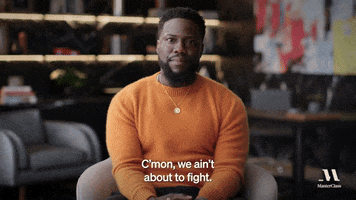How to Talk to Someone Who Doesn’t Like You
Or at least, someone you think doesn’t like you.
Start Here
Our assumptions about how someone feels can be misleading. Before concluding that someone doesn’t like you, consider other possibilities: maybe they’re preoccupied, dealing with personal pressures, or misreading something you said. A moment of curiosity can shift how conversations unfold.
That said, if you truly need to engage with someone who doesn’t seem warm toward you, here are some practical ways to do it.
Treat them like they do like you: If you act cold or disengaged, you hand over control of your emotions. You also place a lot of weight on assumptions that may not even be true. The vibe they’re giving you could come from being socially unaware, having a bad day, or something unrelated to you entirely. And if they really don’t like you, chances are they aren’t important. As the saying goes: “Those that matter don’t mind, and those that mind don’t matter.” Don’t let anyone take away the best parts of your personality.
Stay away from emotions and stay neutral: Keep your tone and words neutral. If you need to interact, be clear about the reason you’re engaging. There’s likely a good purpose for the conversation—focus on that. Stay objective, set limits on scope and time, and resist letting the discussion run longer than it needs to. The longer it goes, the greater the chance it drifts into negativity.
Start with genuine curiosity: “What’s on your mind these days?” invites openness more than “Why are you being distant?” Curiosity signals care and allows space for them to share, if they want to.
Acknowledge tension without accusation: “I’ve felt some distance between us lately. I care about our connection—can we talk?” This frames the issue as shared, not as blame.
Stick to “I”-centered observations: “I’ve noticed we haven’t chatted much lately” is clearer than “You’ve been ignoring me.” It makes the point without putting them on the defensive.
Invite their perspective: “I’m interested in how things feel for you—can you share?” communicates respect and invites honesty.
Talking Points
Treat them like they do like you
Subtle approaches
Hey, good to see you—how’s your day going?
I’d love to hear your thoughts on this.
I wanted to ask your opinion on something.
You’ve got good insight on this—what do you think?
Thanks for being here, I appreciate your input.
Middle-ground approaches
I know we haven’t always talked much, but I’d like to connect better.
I value your perspective and want to hear it.
I want to keep things positive between us.
I’d like to focus on what we have in common.
Direct approaches
I’d like to reset our relationship if you’re open to that.
I want to be clear—I respect you and want us to work well together.
My hope is to treat you as an ally, not an opponent.
Stay away from emotions
Subtle approaches
I wanted to run this by you quickly.
I’ll keep this short—I need your input on one thing.
Can I get your thoughts on this specific point?
Let’s focus just on the main issue here.
Middle-ground approaches
I want to be clear about why I’m reaching out—it’s about [specific reason].
I don’t want to get sidetracked, so I’ll keep this focused.
I’d like to wrap this up in about ten minutes.
I know we see things differently sometimes, but my goal here is [clear objective].
Direct approaches
I want to keep emotions out of this and stick to the facts.
I’ll keep this brief—we need to decide on [specific issue].
Let’s stay focused on the task so this doesn’t get more complicated.
Start with genuine curiosity
Subtle approaches
How have things been going for you?
What’s been keeping you busy lately?
What’s your perspective on this?
How are you feeling about where things stand?
Middle-ground approaches
I feel like I might be missing your side of the story—can you share it with me?
I’d like to understand how you’re seeing this.
Can you walk me through how you’re approaching it?
Direct approaches
I sense some tension between us. Can you tell me what you’re experiencing?
I’d like to clear the air. What’s on your mind?
Acknowledge tension without accusation
Subtle approaches
It feels like we’ve been out of sync—can we talk about that?
I’d like to check in—I may be off, but I’ve felt some distance.
I want to make sure nothing’s getting in the way of our communication.
Middle-ground approaches
I know things haven’t always felt smooth between us. I’d like to work on that.
I’ve sensed some distance, and I’d like to bridge it.
I want to be honest—I’ve been feeling some tension. Can we address it?
Direct approaches
Things feel strained, and I want to clear it up directly.
If there’s something bothering you, I’d like to know.
I’d rather talk this out than let it linger.
Invite their perspective
Subtle approaches
I’d like to hear your side.
What matters most to you in this?
How do you see things going?
Middle-ground approaches
I want to make sure I understand your point of view—can you walk me through it?
What feels most important from your perspective?
I’d like to know what would make this work best for you.
Direct approaches
Tell me what you need here.
What do you think is the main issue between us?
What would help us move forward better?
Suggest a reset or neutral ground
Subtle approaches
Want to grab a coffee and catch up?
Let’s talk about this in a calmer space.
Would you be up for a quick chat outside of work?
Middle-ground approaches
Let’s hit reset. Could we start fresh from here?
I’d like to clear the air and move forward.
I want to put energy into making this better—are you open to that?
Direct approaches
Let’s set aside the past and figure out a better way forward.
I’d like us to reestablish some ground rules for working together.
Can we call this a reset and move on?
A Thought to Carry
Not everyone’s behavior is about you. Assume less, stay steady, and let your kindness and clarity stay intact. Even when someone doesn’t respond warmly, you’ve held on to the best of yourself.





